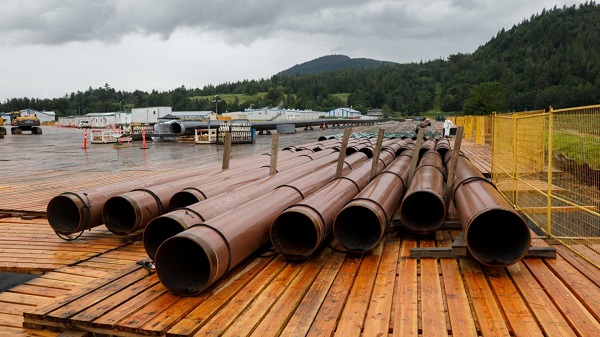Alberta
Investigation concludes suspect convinced girlfriend to lie to police

News Release from ASIRT (Alberta Serious Incident Response Team)
Investigation concluded into use of force during EPS arrest
On Aug. 1, 2018, pursuant to Section 46.1 of the Police Act, the Director of Law Enforcement (DLE) assigned ASIRT to investigate the circumstances surrounding a vehicle pursuit and subsequent arrest of a 31-year-old man. The man had been arrested by members of the Edmonton Police Service (EPS) on July 30 following a brief vehicle pursuit which had resulted in serious injury to an uninvolved pedestrian, and was terminated by intentional contact made by two EPS vehicles.
As is required by the Police Act, these events were reported to the DLE and, based on the information that was known at the time, EPS was directed to maintain conduct of the investigation. Several days later, while being interviewed in relation to that investigation, the man alleged that he had been assaulted during the course of his arrest and had sustained several injuries. This additional information was again reported to the DLE, and ASIRT was directed to assume conduct of the investigation into both the pursuit and any force used during the subsequent arrest of the affected person.
On July 30, 2018, at approximately 12:30 a.m., EPS members operating a marked police vehicle conducted a database check on a red Buick Rendezvous SUV, which revealed the vehicle’s licence plate had been reported stolen. Members followed the vehicle without activating their emergency equipment until the SUV stopped and the driver, later identified as the 31-year-old man, exited. Police then activated their vehicle’s emergency equipment, but the man re-entered the SUV and drove away at a high rate of speed.
Police followed the SUV with emergency equipment activated, and observed the SUV run a red light at 101 Street and 107 Avenue. At this point, several other EPS vehicles had entered the area and additional members were able to observe the SUV. During its flight from police, the vehicle mounted the sidewalk at 102 Street and struck a female pedestrian and a light post. Officers who observed the collision formed the opinion that the collision with the pedestrian was deliberate. Overt action had been required to mount the sidewalk and strike the pedestrian, who was standing in a well-lit area. As well, the man’s vehicle had had an unobstructed path forward with no observable reason or cause to leave the roadway and mount the sidewalk.
After striking the pedestrian and the pole, the SUV continued east on 107 Avenue, with police continuing pursuit. A second EPS vehicle remained at the scene of the collision to render aid to the female pedestrian, who had sustained numerous serious injuries. Having witnessed what appeared to be the deliberate use of the SUV to strike a pedestrian, the driver of the lead EPS vehicle indicated that he believed it was necessary to attempt to end the criminal flight using deliberate vehicle contact. He deliberately struck the rear driver’s side of the SUV, but this tactic failed to stop the vehicle. A marked police van subsequently made deliberate contact with the SUV, this time striking it head-on, and brought the SUV to a halt. The man exited the driver’s seat of the SUV and fled on foot southbound on 103 Street.
Three police officers pursued the man on foot. During this pursuit, the lead officer deployed his conducted energy weapon (CEW), which was successful in bringing the man to the ground. The officer verbally commanded the man to roll onto his stomach, as he had turned onto his back. The man was initially compliant, but resisted when officers attempted to handcuff him. The officer reactivated the CEW, and the man was handcuffed while the CEW was still activated.
Once in custody, the man was observed to be sweating profusely, making spastic movements and acting in a manner that indicated to the arresting officers that he was under the influence of methamphetamine. Accordingly, after searching him, EMS transported the man to hospital.
Medical records obtained during the course of the ASIRT investigation confirmed that at the time of his examination at hospital, the man had a two-centimetre laceration to his forehead which was not actively bleeding, two abrasions on his shoulder area and mild swelling of the front of his head. A CT scan revealed the presence of an age-indeterminate nasal fracture, meaning that doctors were unable to determine whether the nasal fracture had occurred during this event or earlier. Medical staff determined that the man was fit for incarceration, and released him from hospital that same day.
As previously indicated, shortly after he was incarcerated, EPS interviewed the man in the course of their investigation. During that interview, the man described his arrest, discussed his injuries, and asked the interviewer about the condition of the woman he had hit during the incident. Once ASIRT assumed conduct of the investigation, the man was interviewed again – this time by an ASIRT investigator. The man described his flight from police and the collision with the pedestrian but stated that a police vehicle had struck him before the collision with the pedestrian. He also stated that he did not remember hitting anyone.
The man stated that his girlfriend ran away from police following the collision but stopped to watch his arrest. He stated that she told him that at one point six police officers were beating him. The man stated that he did not remember this, but recommended that ASIRT interview his girlfriend. He further stated that at the time of the incident he was under the influence of methamphetamine, which he had used approximately five hours before the incident. He stated that his girlfriend was under the influence of heroin, which she had consumed approximately one hour before the incident.
The man’s girlfriend was interviewed twice during the course of this investigation, once by EPS and once by ASIRT. During the first interview by EPS, she stated that she had been the lone passenger in the vehicle being operated by her boyfriend. She indicated that he had lost control of the vehicle while turning and began to drive on the sidewalk before striking a lamppost. She stated that neither of them was aware at the time that they had struck a pedestrian. During the statement, she indicated that when the final collision with the police vehicle occurred, the man jumped out of the vehicle first and was pursued by police. She stated that she ran from the scene to a friend’s house, where, through a third party, she contacted her boyfriend in jail, but advised that they did not discuss the incident. In addition to describing the events, she confirmed the man’s statements regarding her use of heroin prior to the incident.
The next day, after the case was assigned to ASIRT, the man’s girlfriend was interviewed again by ASIRT investigators. During this interview, she confirmed that she had recently spoken to her boyfriend and now suggested that the police had struck the SUV, causing the collision with the pedestrian and minimizing the man’s role in the incident. She now stated that following the final collision, she ran and hid under a car that was approximately 10 to 20 metres away. As she watched her boyfriend’s arrest, she alleged she saw police assault him.
As a result of the discrepancies between their various versions of the incident and the conversations that took place between them after the man’s arrest, ASIRT investigators took the unusual step of obtaining a judicial authorization for access to the man’s communications while in custody at the Edmonton Remand Centre. The recorded calls revealed repeated attempts by the man to influence the evidence of his girlfriend in conversations directly with her and with other parties. On several occasions, the man referenced the impact that her assistance would have on his chances of getting bail on the charges arising from the incident. During two of the calls, the man’s girlfriend described the striking of the pedestrian, saying that she remembered her being in the way, running and screaming. The man advised her to downplay that aspect of the story when dealing with the police, and to state that she was not sure of the details.
During the calls, the man repeatedly exaggerated the extent of his dealings with police, stating that he had smashed four police vehicles, that he had four CEWs used upon him, had received four broken bones in his face during the incident, and had sustained dog bites during his arrest. His girlfriend’s response to these statements clearly demonstrated that she had not witnessed the arrest. It appeared that in a number of the exchanges, the man attempted to instil fear in his girlfriend in order to ensure her cooperation, and encouraged her to turn herself in to police, which he repeatedly suggested would help him.
In addition to the recorded calls, the independent evidence of three civilian witnesses and CCTV video from an area business confirmed that the man’s girlfriend did not witness his arrest as described in her second statement, but rather had immediately fled the area as she had initially described.
Despite being under no obligation to do so, each of the three police officers directly involved in the arrest of the man provided voluntary statements to ASIRT for use during the investigation. One officer acknowledged deploying his CEW during the foot pursuit of the man, which resulted in the man falling to the ground. When the man continued to struggle on the ground, and was described as actively resistant, the officer reactivated his CEW, which allowed him, with the assistance of the other two involved officers, to place the man in handcuffs. The three officers directly involved in the man’s arrest, along with all witness officers interviewed, denied participating in or witnessing any significant use of force as described by the man and his girlfriend.
On the basis of the information available to police during this incident, they were lawfully placed to arrest the man in relation to a number of Criminal Code offences, including possession of stolen property and criminal flight causing bodily harm. As the officers were engaged in the lawful execution of their duty, they were authorized by Sec. 25 of the Criminal Code to use a reasonable amount of force necessary to carry out their duties.
While the description of the amount of force used during the incident varies widely between the descriptions provided by police and the man and his girlfriend, when looking at the evidence in this matter as a whole, it is impossible to place any weight whatsoever on the versions offered by the man and his girlfriend.
In addition to the significant inconsistencies between the versions offered by both the man and his girlfriend in their own multiple statements, which would on their own significantly compromise the ability to rely upon their evidence, the recorded attempts by the man to influence the evidence of his girlfriend in hopes of convincing her to tailor her evidence to match his own is fatal to the credibility of both witnesses. Independent evidence conclusively established that the girlfriend was not present to witness the arrest.
Based on the available reliable evidence, the force used to arrest the man was both reasonable and necessary. Once restrained in handcuffs, there were no additional uses of force, and the man was taken into custody without further incident. Furthermore, it is clear from an assessment of all the evidence in this matter that the cause of the initial collision with the pedestrian was the man’s deliberate driving pattern and that there was no physical contact with the SUV by any police vehicle before the pedestrian was struck.
There are no reasonable grounds, nor reasonable suspicion, to believe that any of the officers committed any Criminal Code offence(s). The officers were lawfully placed in their actions with the man, and the force employed was reasonable and necessary in the circumstances. As such, no charges are appropriate, and ASIRT’s involvement in the matter is concluded.
ASIRT’s mandate is to effectively, independently and objectively investigate incidents involving Alberta’s police that have resulted in serious injury or death to any person, as well as serious or sensitive allegations of police misconduct.
Alberta
Here’s why city hall should save ‘blanket rezoning’ in Calgary

From the Fraser Institute
By Tegan Hill and Austin Thompson
According to Calgarians for Thoughtful Growth (CFTG)—an organization advocating against “blanket rezoning”— housing would be more affordable if the mayor and council restricted what homes can be built in Calgary and where. But that gets the economics backwards.
Blanket rezoning—a 2024 policy that allowed homebuilders to construct duplexes, townhomes and fourplexes in most neighbourhoods—allowed more homebuilding, giving Calgarians more choice, and put downward pressure on prices. Mayor Farkas and several councillors campaigned on repealing blanket rezoning and on December 15 council will debate a motion that could start that process. As Calgarians debate the city’s housing rules, residents should understand the trade-offs involved.
When CFTG claims that blanket rezoning does “nothing” for affordability, it ignores a large body of economic research showing the opposite.
New homes are only built when they can be sold to willing homebuyers for a profit. Restrictions that limit the range of styles and locations for new homes, or that lock denser housing behind a long, costly and uncertain municipal approval process, inevitably eliminate many of these opportunities. That means fewer new homes are built, which worsens housing scarcity and pushes up prices. This intuitive story is backed up by study after study. An analysis by Canada’s federal housing agency put it simply: “higher residential land use regulation seems to be associated with lower housing affordability.”
CFTG also claims that blanket rezoning merely encourages “speculation” (i.e. buying to sell in the short-term for profit) by investors. Any profitable housing market may invite some speculative activity. But homebuilders and investors can only survive financially if they make homes that families are willing to buy or rent. The many Calgary families who bought or rented a new home enabled by blanket rezoning did so because they felt it was their best available option given its price, amenities and location—not because they were pawns in some speculative game. Calgarians benefit when they are free to choose the type of home and neighbourhood that best suits their family, rather than being constrained by the political whims of city hall.
And CFTG’s claim that blanket rezoning harms municipal finances also warrants scrutiny. More specifically, CFTG suggests that developers do not pay for infrastructure upgrades in established neighbourhoods, but this is simply incorrect. The City of Calgary charges an “Established Area Levy” to cover the cost of water and wastewater upgrades spurred by redevelopment projects—raising $16.5 million in 2024 alone. Builders in the downtown area must pay the “Centre City Levy,” which funds several local services (and generated $2.5 million in 2024).
It’s true that municipal fees on homes in new communities are generally higher, but that reflects the reality that new communities require far more new pipes, roads and facilities than established neighbourhoods.
Redeveloping established areas of the city means more residents can make use of streets, transit and other city services already in place, which is often the most cost-effective way for a city to grow. The City of Calgary’s own analysis finds that redevelopment in established neighbourhoods saves billions of taxpayer dollars on capital and operating costs for city services compared to an alternative scenario where homebuilding is concentrated in new suburban communities.
An honest debate about blanket rezoning ought to acknowledge the advantages this system has in promoting housing choice, housing affordability and the sustainability of municipal finances.
Clearly, many Calgarians felt blanket rezoning was undesirable when they voted for mayoral and council candidates who promised to change Calgary’s zoning rules. However, Calgarians also voted for a mayor who promised that more homes would be built faster, and at affordable prices—something that will be harder to achieve if city hall imposes tighter restrictions on where and what types of homes can be built. This unavoidable tension should be at the heart of the debate.
CFTG is promoting a comforting fairy tale where Calgary can tighten restrictions on homebuilding without limiting supply or driving up prices. In reality, no zoning regime delivers everything at once—greater neighbourhood control inevitably comes at the expense of housing choice and affordability. Calgarians—including the mayor and council—need a clear understanding of the trade-offs.
Alberta
The case for expanding Canada’s energy exports

From the Canadian Energy Centre
For Canada, the path to a stronger economy — and stronger global influence — runs through energy.
That’s the view of David Detomasi, a professor at the Smith School of Business at Queen’s University.
Detomasi, author of Profits and Power: Navigating the Politics and Geopolitics of Oil, argues that there is a moral case for developing Canada’s energy, both for Canadians and the world.
CEC: What does being an energy superpower mean to you?
DD: It means Canada is strong enough to affect the system as a whole by its choices.
There is something really valuable about Canada’s — and Alberta’s — way of producing carbon energy that goes beyond just the monetary rewards.
CEC: You talk about the moral case for developing Canada’s energy. What do you mean?
DD: I think the default assumption in public rhetoric is that the environmental movement is the only voice speaking for the moral betterment of the world. That needs to be challenged.
That public rhetoric is that the act of cultivating a powerful, effective economic engine is somehow wrong or bad, and that efforts to create wealth are somehow morally tainted.
I think that’s dead wrong. Economic growth is morally good, and we should foster it.
Economic growth generates money, and you can’t do anything you want to do in social expenditures without that engine.
Economic growth is critical to doing all the other things we want to do as Canadians, like having a publicly funded health care system or providing transfer payments to less well-off provinces.
Over the last 10 years, many people in Canada came to equate moral leadership with getting off of oil and gas as quickly as possible. I think that is a mistake, and far too narrow.
Instead, I think moral leadership means you play that game, you play it well, and you do it in our interest, in the Canadian way.
We need a solid base of economic prosperity in this country first, and then we can help others.
CEC: Why is it important to expand Canada’s energy trade?
DD: Canada is, and has always been, a trading nation, because we’ve got a lot of geography and not that many people.
If we don’t trade what we have with the outside world, we aren’t going to be able to develop economically, because we don’t have the internal size and capacity.
Historically, most of that trade has been with the United States. Geography and history mean it will always be our primary trade partner.
But the United States clearly can be an unreliable partner. Free and open trade matters more to Canada than it does to the U.S. Indeed, a big chunk of the American people is skeptical of participating in a global trading system.
As the United States perhaps withdraws from the international trading and investment system, there’s room for Canada to reinforce it in places where we can use our resource advantages to build new, stronger relationships.
One of these is Europe, which still imports a lot of gas. We can also build positive relationships with the enormous emerging markets of China and India, both of whom want and will need enormous supplies of energy for many decades.
I would like to be able to offer partners the alternative option of buying Canadian energy so that they are less reliant on, say, Iranian or Russian energy.
Canada can also maybe eventually help the two billion people in the world currently without energy access.
CEC: What benefits could Canadians gain by becoming an energy superpower?
DD: The first and primary responsibility of our federal government is to look after Canada. At the end of the day, the goal is to improve Canada’s welfare and enhance its sovereignty.
More carbon energy development helps Canada. We have massive debt, an investment crisis and productivity problems that we’ve been talking about forever. Economic and job growth are weak.
Solving these will require profitable and productive industries. We don’t have so many economic strengths in this country that we can voluntarily ignore or constrain one of our biggest industries.
The economic benefits pay for things that make you stronger as a country.
They make you more resilient on the social welfare front and make increasing defence expenditures, which we sorely need, more affordable. It allows us to manage the debt that we’re running up, and supports deals for Canada’s Indigenous peoples.
CEC: Are there specific projects that you advocate for to make Canada an energy superpower?
DD: Canada’s energy needs egress, and getting it out to places other than the United States. That means more transport and port facilities to Canada’s coasts.
We also need domestic energy transport networks. People don’t know this, but a big chunk of Ontario’s oil supply runs through Michigan, posing a latent security risk to Ontario’s energy security.
We need to change the perception that pipelines are evil. There’s a spiderweb of them across the globe, and more are being built.
Building pipelines here, with Canadian technology and know-how, builds our competitiveness and enhances our sovereignty.
Economic growth enhances sovereignty and provides the resources to do other things. We should applaud and encourage it, and the carbon energy sector can lead the way.
-

 Automotive2 days ago
Automotive2 days agoThe $50 Billion Question: EVs Never Delivered What Ottawa Promised
-

 Local Business2 days ago
Local Business2 days agoRed Deer Downtown Business Association to Wind Down Operations
-

 International2 days ago
International2 days agoTrump admin wants to help Canadian woman rethink euthanasia, Glenn Beck says
-

 Agriculture2 days ago
Agriculture2 days agoGrowing Alberta’s fresh food future
-

 C2C Journal2 days ago
C2C Journal2 days agoWisdom of Our Elders: The Contempt for Memory in Canadian Indigenous Policy
-

 Alberta2 days ago
Alberta2 days agoAlberta introducing three “all-season resort areas” to provide more summer activities in Alberta’s mountain parks
-

 Alberta2 days ago
Alberta2 days agoThe case for expanding Canada’s energy exports
-

 Censorship Industrial Complex2 days ago
Censorship Industrial Complex2 days agoConservative MP calls on religious leaders to oppose Liberal plan to criminalize quoting Scripture









